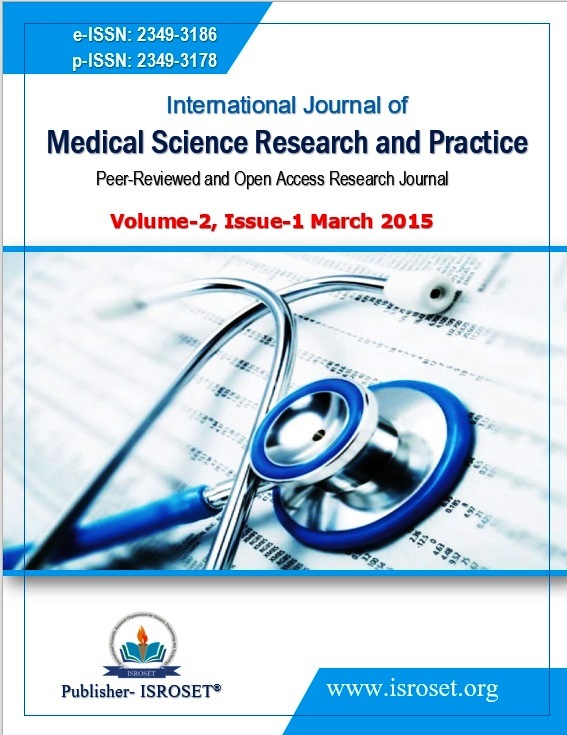Clinico-Histopathological correlation of leprosy: A retrospective study of skin biopsy specimens in Chitwan Medical College
Keywords:
Bacillary index, macules, Mycobacterium leprae, Ridley and Jopling classificationAbstract
Aim- Aim of this study was to find out cases of leprosy diagnosed in skin biopsy specimen and to study clinicohistopathological correlation in diagnosis of leprosy.
Background- Leprosy is caused by Mycobacterium leprae. There are various clinico-pathological forms of leprosy depending on the immune status of the host. Diagnosis of leprosy can be done by clinical, microbiological and histopathological examination. Histopathological examination is considered as
important for confirmatory diagnosis, for assessment of regression of the disease in patient under treatment and also for research purposes. Number of skin lesions in patients, Ridley and Jopling (RJ) classification and bacilliary index in histological sample all can be correlated for proper classification and treatment of leprosy cases.
Materials and Methods- This retrospective study included cases of leprosy diagnosed in skin biopsy specimen in the Department of Pathology of Chitwan Medical College from April 2009 to March 2014. Clinical diagnosis was correlated with that of histopathological diagnosis.
Results- In this study, male to female ratio was 1.4:1. Mean age of patients was
32.66 years. Most common lesion was hypopigmented macule (68%). On the basis of RJ scale, maximum cases (41%) were classified as borderline tuberculoid leprosy (BT) and least number (3.7%) as leprosy, and polar lepromatous leprosy. Maximum clinico-histopathological correlation was seen in borderline lepromatous leprosy (87.5%) followed by BT (68.1%). Fite ferraco stain was done in only 27 cases. It was 0-2 in tuberculoid spectrum and >2 in lepromatous spectrum.
Conclusion- Combining clinical, histopathological and microbiological diagnosis of leprosy is important for
proper treatment of the patient and prevention of complications.
References
Bhat RM, Prakash C. Leprosy: An overview of pathophysiology. Interdiscip Perspect Infect Dis 2012;2012:181089.
Park JE, Park K. Epidemiology of communicable diseases. In: Preventive and Social Medicine. Jabalpur: Banarasidas Bhanol; 1991. p. 215-25.
Khan I, Khan AR, Khan MS. Clinicopathological study of 50 cases of leprosy. J Pak Assoc Dermatol 2012;22:200-6.
Sharma A, Kumar RS, Goswsami CK, Bardwaj S. Clinicohistopathological correlation in leprosy. JK Sci 2008;10:120-3.
Manandhar U, Adhikari RC, Sayami G. Clinico-histopathological correlation of skin biopsies in leprosy. J Pathol Nepal 2013;3:452-8.
Walker SL, Lockwood DN. The clinical and immunological features of leprosy. Br Med Bull 2006;77-78:103-21.
Parkash O. Classifi cation of leprosy into multibacillary and paucibacillary groups: An analysis. FEMS Immunol Med Microbiol 2009;55:1-5.
Shivamurthy V, Gurubasavaraj H, Sastry SP, Kumar P. Histomorphological study of leprosy. Afr J Med Health Sci 2013;12:68-73.
Pardillo FE, Fajardo TT, Abalos RM, Scollard D, Gelber RH. Methods for the classifi cation of leprosy for treatment purposes. Clin Infect Dis 2007;44:1096-9.
Jha AK. Leprosy: Before and after elimination from Nepal. Kathmandu Univ Med J (KUMJ) 2012;10:1-2.
Gupta R, Kar HK, Bharadwaj M. Revalidation of various clinical criteria for the classifi cation of leprosy – A clinic-pathological study. Lepr Rev 2012;83:354-62.
Rad F, Ghaderi E, Moradi G, Salimzadeh H. The study of disability status of live leprosy patients in Kurdistan province of Iran. Pak J Med Sci 2007;23:857-61.
Pathak DT, Jha AK. Clinico -histopathological correlation in leprosy: A tertiary care hospital based study. Our Dermatol Online 2013;4:294-6.
Peters ES, Eshiet AL. Male-female (sex) differences in leprosy patients in south eastern Nigeria: Females present late for diagnosis and treatment and have higher rates of deformity. Lepr Rev 2002;73:262-7.
Varkevisser CM, Lever P, Alubo O, Burathoki K, Idawani C, Moreira TM, et al. Gender and leprosy: Case studies in Indonesia, Nigeria, Nepal and Brazil. Lepr Rev 2009;80:65-76.
Badhan R, Kundal RK, Raj RT, Bahl RK, Bal MS. A clinicopathological correlation study of leprosy in a tertiary care teaching institute in Northwest Punjab, India. Am J Med Sci Med 2014;2:99-108.
Vargas-Ocampo F. Analysis of 6000 skin biopsies of the national leprosy control program in Mexico. Int J Lepr Other Mycobact Dis 2004;72:427-36.
Bhatia AS, Katoch K, Narayanan RB, Ramu G, Mukherjee A, Lavania RK. Clinical and histopathological correlation in the classifi cation of leprosy. Int J Lepr Other Mycobact Dis 1993;61:433-8.
Moorthy BN, Kumar P, Chatura KR, Chandrasekhar HR, Basavaraja PK. Histopathological correlation of skin biopsies in leprosy. Indian J Dermatol Venereol Leprol 2001;67:299-301.
Nadkarni NS, Rege VL. Signifi cance of histopathological classifi cation in leprosy. Indian J Lepr 1999;71:325-32.
Giridhar M, Arora G, Lajpal K, Singh Chahal K. Clinicohistopathological concordance in leprosy - a clinical, histopathological and bacteriological study of 100 cases. Indian J Lepr 2012;84:217-25.
Pandya AN, Tailor HJ. Clinicohistopathological correlation of leprosy. Indian J Dermatol Venereol Leprol 2008;74:174-6.
Chatura KR, Sangeetha S. Utility of Fite-Faraco stain for both mast cell count and bacillary index in skin biopsies of leprosy patients. Indian J Lepr 2012;84:209-15.
Suri SK, Iyer RR, Patel DU, Bandil S, Baxi S. Histopathology and clinico-histopathological correlation in Hansen’s disease. J Res Med Dent Sci 2014;2:37-44.
Downloads
Published
How to Cite
Issue
Section
License

This work is licensed under a Creative Commons Attribution 4.0 International License.
Authors contributing to this journal agree to publish their articles under the Creative Commons Attribution 4.0 International License, allowing third parties to share their work (copy, distribute, transmit) and to adapt it, under the condition that the authors are given credit and that in the event of reuse or distribution, the terms of this license are made clear.






